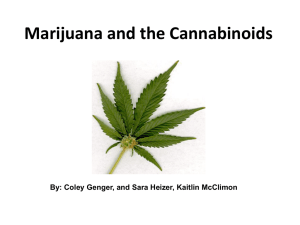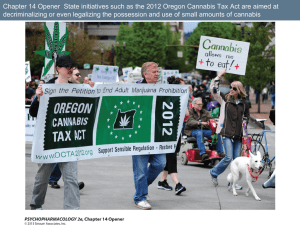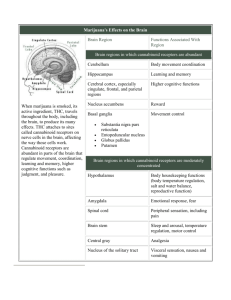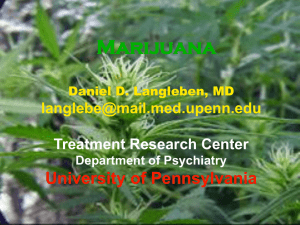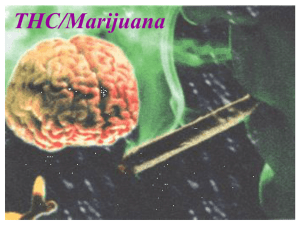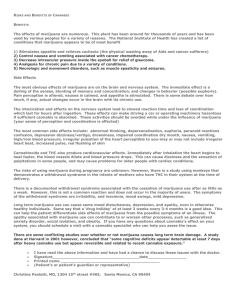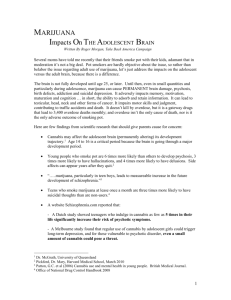Psychopharmacology
advertisement
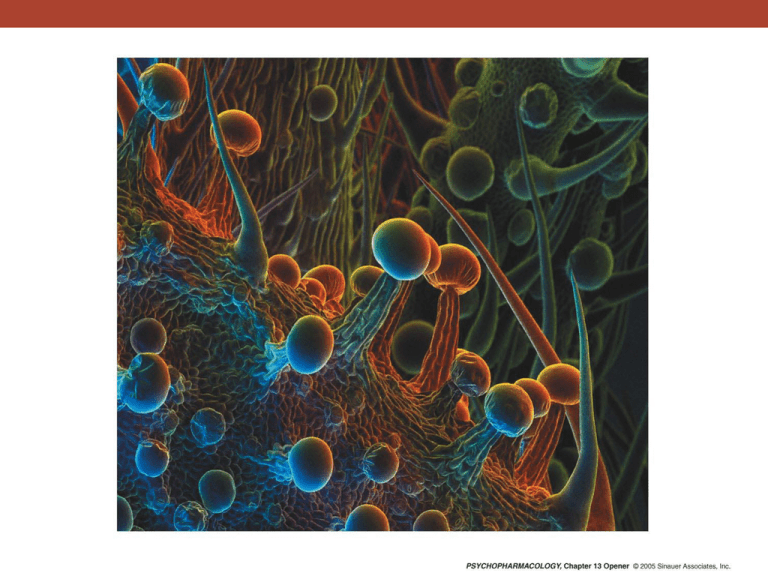
Background and History of Marijuana • Produced from the flowering hemp (Cannabis Sativa). • Hemp was historically important as a major source of fiber for rope making – Shipping • Contains more than 60 unique compounds collectively known as cannabinoids • Some of these compounds are psychoactive – Δ9 – tetrahydrocannabinol (THC) Background and History • Cannabis can be obtained in a number of forms – Marijuana – mixture of dried leaves, small stems, and flowering tops of Cannabis plants • Usually smoked • Can be consumed (often in baked goods – cookies or brownies). • Potency varies depending on – genetic strain – growing conditions » If you prevent pollination (which prevents seed production in female plants) you can achieve higher potency » Known as sinsemilla (without seeds) Background and History • Hashish – Collected and pressed plant resin – Can be smoked or eaten – Potency depends on how collected, but it is generally more potent than marijuana • Hash oil – An even more potent extract of the marijuana plant resin – Sometimes a drop is placed on a typical cigarette and smoked. – Or a drop can be added to a marijuana cigarette to increase its dose. 13.3 The potent form of cannabis called hashish Hash Oil Background and History • Cannabis is thought to have originated in central Asia (probably China). • There is evidence of hemp rope dating back to 8,000 B.C. • Western interest did not begin until the early to mid nineteenth century. • Napoleon’s soldiers thought to have brought hashish back to France from Egypt • French physician Jacques-Joseph Moreau also brought hashish back to Paris after traveling to the Middle East. – “club of hashish eaters” • Writers and artists Background and History in US • Dates back to colonial era • George Washington was a hemp farmer – Unlikely aware of psychoactive effects – Grown for fiber • Practice of smoking marijuana likely brought into the US in the early 1900s – Mexican/American border • Mexican immigrants – New Orleans and other ports on the Gulf of Mexico • Caribbean sailors • West Indian immigrants Background and History in US • Marijuana use spread rapidly in the US • Marijuana tax act in 1937 • Overturned by Supreme Court in 1969 • Controlled substances Act of 1970 – Schedule 1 drug. Basic Pharmacology of Marijuana • Israeli researchers: Gaoni and Mechoulam (1964) identified THC as the major active ingredient of Cannabis Sativa. Basic Pharmacology of Marijuana • A typical joint consists of around 0.5 grams to 1 gram of cannabis. – THC content can be around 4% or higher – If about 4% then a 1 gram joint contains about 40 mg of THC • Burning causes the THC to vaporize and enter the smokers lungs in small particles – Only about 20% of the original THC content gets absorbed • There can be substantial variation in the amount of THC absorbed based on – The potency of the marijuana – The amount smoked – The pattern of smoking Basic Pharmacology of Marijuana • Experienced marijuana users regulate the volume and frequency of “puff” to control the behavioral effects of the drug. – Interestingly controlled experimental studies have failed to show a substantial effect of breath holding – Though Block et al. (1998) found that there was a modest subjective effect of breath holding for 15 seconds rather than 7 seconds. • So there may be something to the practice of holding the smoke in. Basic Pharmacology of Marijuana • THC is absorbed through the lungs • Causes rapidly rising levels of THC in blood plasma • After peak levels are reached, Plasma THC levels begin to decline – Metabolism by liver – Accumulation of the drug in fat stores Basic Pharmacology of Marijuana • Oral consumption of marijuana – Leads to prolonged but poor absorption of THC • Results in low and variable plasma concentrations • Probably due to degradation in stomach, and first pass metabolism by the liver. • THC is converted into several metabolites – 11-hydroxy-THC – 11-nor-carboxy-THC (THC-COOH) • These metabolites are excreted in feces and urine – Blood levels of marijuana decline quickly – But elimination from the body is much slower. • The drug persists in fatty tissue • Sensitive urine screening tests can detect THC-COOH more than 2 weeks following last use. Mechanism of Action • • It wasn’t until 1988 that the receptors for cannabanioids were discovered Subsequently, it was discovered that cannabinoid receptors were expressed in many brain regions, including the: – – – – Basal ganglia Cerebellum Hippocampus Cerebral cortex • – Also limbic system • • – • Especially frontal cortex Hypothalamus Anterior cingulate cortex Absence of receptors in brain stem may explain low toxicity (hard to overdose). Key for image – – CB1 receptor densities Yellow>Red>Blue • Not surprisingly the location of cannabinoid receptors correspond with the behavioral effects of cannabinoids – Locomotor activity – Coordination – Memory • There are 2 forms of the cannabinoid receptors – CB1 in the CNS – CB2 in the periphery (seems to be involved in immune system). CB1 receptors • Metabotropic – Inhibition of cAMP – Inhibition of voltage sensitive CA++ channels – Activation of K+ channels • Excitation or Inhibition? • Typically the receptors exist on the axon terminal rather than on the postsynaptic cell. – Affects many neurotransmitter systems • • • • • • Acetylcholine Dopamine Norepinephrine Serotonin Glutamate GABA Agonists and Antagonists • THC is of course the classic cannabinoid receptor agonist • First useful antagonist was developed in 1994 – SR 141716 (rimonabant) – Selective antagonist for CB1 receptors – Orally active (thus, easy to administer to humans) • We will discuss the effects of this drug later Endocannababinoids • The existence of cannabinoid receptors led researchers to search for an endogenous neurotransmitter – Israeli scientists: Devane et al. (1992) – Arachidonoyl ethanolamide • Anandamide • From Sanskrit - ananda “bringer of inner bliss and tranquility” • Other endogenous substances have now been found – Collectively referred to as the endocannabinoids • The endocannabanoids are generated from arachidonic acid – A fatty acid found in the cell membrane • Unlike classic neurotransmitters they are very lipid soluble – Can’t be stored in vesicles • Would pass right through the membrane • Believed they are made and released as needed – One mechanism appears to be a rise in intracellular Ca++ levels. • Enzymes involved in generation of endocannabinoids are Ca++ sensitive • After release endocannabinoids are taken up from the extracellular fluid by specific transporters – Seems to inactivate endocannabinoids • Inhibition of this transporter (AM 404) enhanced the effects anandamide in animals – Once in the cell endocannabinoids are metabolized be enzymes • Fatty acid amide hydrolase (FAAH) • Genetic knock out mice that lack FAAH show elevated anandamide levels in the brain • Endocannabinoids appear to work by modulating the effects of other neurotransmitter systems • Either by suppressing inhibition of interneurons – Depolarization induced suppression of inhibition (DSI) • Suppress activity of GABA releasing neurons • Or by suppressing excitation of interneurons – Depolarization induced suppression of excitation (DSE) • Suppress activity of Glutamate releasing neurons. Depolarization-induced Suppression of Inhibition - DSI • Depolarization-induced suppression of inhibition (DSI) – Known to occur for some time. – A form of fast acting retrograde signaling • Remember nitric oxide? – Prominent effect in the hippocampus and cerebellum • Endocannabinoids appear to be retrograde messengers – The are synthesized and released in response to depolarization of the post synaptic cell • Influx of Ca++ through voltage gated channels – Following release they cross the synaptic cleft and activate CB1 receptors • They then inhibit neurotransmitter release from the presynaptic terminal • In the hippocampus (an example) – Endocannibinoids are generated by pyramidal neurons (principle output neurons of the hippocampus) • Diffuse to nearby GABAergic interneurons and inhibit them • Inhibition of GABA release allows the pyramidal cells to fire more rapidly – Inhibition of inhibition = excitation • Similar mechanisms likely occur in other brain regions and other neurotransmitter systems 13.9 Retrograde signaling by endocannabinoids reduces GABAergic inhibition Evidence that endocannabinoids play a role in DSI • Ohno-Shosaku et al. (2001) – Cultured hippocampal neurons – Found that depolarization of the postsynaptic neurons lead to suppression of inhibition in about 2/3 of neuron pairs • Due to inhibition of GABA – Those neurons that displayed DSI responded to the CB1 synthetic agonist (WIN55, 2122) • Mimicked DSI – Rimonabant blocked this effect Evidence that endocannabinoids play a role in DSI • Varma et al. (2001) – DSI was completely absent in hippocampal slices prepared from CB1 receptor knockout mice • There is also a phenomenon known as depolarization-induced suppression of excitation (DSE). – This involves suppression of typical excitation produced by glutamate – Cannabinoids appear to play a role here as well. Iversen 2003 • These findings suggest that endocannabinoids are involved in the rapid modulation of synaptic transmission in the CNS via a retrograde signaling system. – Causing inhibitory effects on both excitatory and inhibitory neurotransmitter release that persists for tens of seconds • When we take cannabinoids they cause long-lasting activation of CB1 receptors in all brain regions – Rather than short localized effects • This will temporarily override any modulatory effects that cannabinoids normally cause Acute Behavioral Effects • Iversen (2000) separates the subjective effects of moderate doses of marijuana into four stages – 1) The “buzz” • A brief period of initial responding – Lightheaded – Perhaps slightly dizzy – Tingling sensation in extremities is fairly common – 2) The “high” • Feelings of euphoria and exhilaration • Sense of disinhibition • Often manifested as increased laughter. 3) “stoned” • Calm, relaxed, dreamlike state • Sometimes people report – – – – – Floating sensation Enhanced visual and auditory perception Visual illusions Tremendous slowing of time passage Some feel increased sociability; others feel a desire to be alone 4) “comedown” • Often preceded by hunger, or empty feeling in stomach “munchies” • People report feeling tired, listless, weak. – Everyone initially very talkative, but as they comedown conversations slows and people become sleepy • Usually leads to sleep sometimes with colorful dreams • Marijuana can cause strong feelings of anxiety, panic, or paranoia. – More likely to be reported by first time users, or the result of taking large doses of the drug Acute Physiological effects • Increased blood flow to the skin – Sensation of warmth or flushing • Increased heart rate – Pounding pulse • Increase in hunger – Munchies • Recognized as a therapeutic effect of marijuana • Expectations about the drug can influence the effects of the marijuana – Kirk et al. (1998) • Some given THC capsules • Some given placebo • Some informed • Some uninformed – Informed group gave higher ratings for liking the drug and wanting more drug • This was also true for the group that received placebo, but were told they received THC • The subjective effects of marijuana are at least partially mediated by CB1 receptors. – Self reports of feeling high or stoned were significantly inhibited by the antagonist SR 141716 • Notice the same sort of effects occurred for heart rate (a less subjective measure). • Unknown if there is more than one mechanism of marijuana effects, or if they didn’t use a high enough dose of antagonist to fully block the effects. Therapeutic uses of cannabinoids • Antiemetic effects – There are presently synthetic forms of THC that are prescribed to treat the nausea and emesis (vomiting) associated with chemotherapy • Dronabinol • Nabilone – Animal Studies have shown that this effect appears to be CB1 dependent. – In fact in one susceptible species (the shrew) the CB1 antagonist rimonabant is emetic. • This effect can be blocked by THC or WIN55,2122 Appetite stimulant • Dronabinol is also approved for use as an appetite stimulant in AIDS patients suffering from anorexiacachexia (wasting syndrome). – THC also stimulates food intake in experimental animals • For high-fat or sweet high-fat diets • Not for lab chow • This effect is blocked by rimonabant – Rimonabant given on its own suppresses food intake • Led to reduced body weight in adult non-obese rats. • Implicates CB1 receptors • Perhaps a treatment for obesity? • These effects may work through the appetite suppressing hormone leptin. – hypothalamus Cannabinoids and pain • Cannabis was widely used in the 19th century for pain relief • Cannabinoid receptors exist at various levels in the pain pathway – Peripheral nerve endings in the spinal cord – Anterior cingulate cortex Animal studies • Animal studies show that THC and synthetic cannabinoids have antinociceptive effects. – Have to rule out motor effects • Cannabinoids decrease activity – Typically measure how quickly an animal will avoid pain » Hot plate » Tail flick – Could be same pain but less movement Cannabinoids, pain relief, animal studies • Shown that cannabinoids suppress electrophysiological responses of spinal cord neurons to pain • Shown that cannabinoids work when injected directly into spinal cord, brain stem, or spinal cord – Localized effects that should be less likely to affect activity levels • The anti-nociceptive effects of cannabinoids are blocked by rimonabant – Showing that CB1 receptors are directly involved • Pain increases release of anandamide in the periaquaductal grey Cannabinoids and pain relief • There is evidence that there may be an interaction between the cannabinoid and the opioid system in the relief of pain – The systems seem to potentiate each other – This potentiation can be blocked by rimonabant or naloxone • Indicating that both CB1 and opiate receptors are involved • There is also evidence that cannabinoids may have some benefit for – – – – Glaucoma (pressure in the eye) Multiple sclerosis Spinal cord injury Traumatic brain injury • Development of cannabinoid clinical applications has been slow • Why? – Lack of large scale controlled clinical studies • Federal government tends to discourage efforts to develop and license new cannibinoid medicatons – Concerns about psychoactivity • cannabinoids are psychoactive even if taken orally – This leads some physicians to be concerned about abuse – Route of administration • Works best if smoked • Daily smoking can cause respiratory issues • Nevertheless, some states have legalized smoking marijuana Marijuana use can lead to deficits in cognition • Clinical accounts of marijuana intoxication have noted deficits in thought processes and verbal behavior – Illogical disordered thinking – Fragmented speech – Difficulty remaining focused on a given topic of conversation • Experimental assessment – There are decrements on a variety of tasks • Verbal – Recall and recognition of word lists Cognitive deficits • Spatial working memory: Ilan et al. (2003) A dot stimulus was displayed in one of six positions on each trial. Subjects had to decide whether the spatial location of the dot on each trial matched the location of the dot two trials before. Because which dot occurred two trials before changes with each passing trial, this task requires frequent manipulation of to-be-remembered items. Cognitive deficits • Time estimation – Lieving et al. (2006) • Asked to push one button for a short sample (2-s) and a different button after a long sample (4-s) – train until performing well • Test with a variety of samples between 2- and 4-s • Those on marjiuana were more likely to judge time samples as long. – Indicating that time had sped up for the individual making short intervals seem long Cognitive deficits • Explicit memory – Oral Dronabinol (Marinol) – Subjects listened to a short written passage • Similar to a news bulletin on the radio • Tested before and after drug or placebo administration – 1 hour before = 0 point on next graph – They were then tested again 2 and 6 hours after treatment Cognitive deficits • Low dose of THC did not affect memory • High dose clearly did • Memory for the content of a story compares nicely with real world task of following a conversation. Cognitive deficits • Clearly there are many cognitive effects of marijuana intoxication • There is evidence that prior usage of marijuana can reduce these adverse cognitive effects – Behavioral “cognitive” tolerance? • Learn to focus / pay more attention? Psychomotor performance • Low doses of marijuana do not affect psychomotor performance much • Higher doses do, even for regular users – Particularly for demanding tasks • Like driving. Animal studies • Early studies show that THC can cause motor impairments, cataplexy (lack of voluntary movement), hypothermia, and analgesia. • Most of the behavioral effects of THC are abolished in CB1 receptor knockout mice. – Indicating these effects are mediated by CB1 receptors Effects on animal learning and memory • Cannabinoids disrupt performance on several learning tasks – Radial arm maze – Morris water maze – Delayed non-match-to-position task. • Left or right bar – Insert one – When rat responds the bar is retracted • Impose delay • Insert both bars – Must choose the 1 that was not presented initially • Considered a test of short term memory Effects on animal learning and memory • Cannabinoids can impair radial arm maze performance when injected directly into hippocampus • It has also been shown that activation of CB1 receptors in the hippocampus decreases hippocampal synaptic transmission and interferes with long-term potentiation • Perhaps the effects in humans are also due to impaired hippocampal functioning Effects on animal learning and memory • There is evidence that CB1 receptors may be involved in extinction or reversal learning • Varvel and Lichtman (2002) found the CB1 knockout mice show impaired reversal learning in the Morris Water Maze – Perseverate? – Damage to which brain area tends to cause perseveration? – There is also evidence that humans exposed to marijuana have a decreased ability to inhibit responding Cannabinoids are reinforcing to both humans and other animals • Chait and Zacny (1992) found that regular marijuana users could discriminate marijuana from placebo cigarettes – All preferred marijuana if given a choice – Same effects occurred with pure THC taken orally compared to placebo • Also shown that marijuana users preferred 1.95% THC content to 0.63% THC Marijuana and reward in animals • It was initially thought that animals did not find marijuana rewarding. – Perhaps early studies used too high of doses leading to aversive reactions • Squirrel monkeys have been shown to self-adminster THC – These studies used lower doses within the range of a single drag of marijuana • Lever pressing was blocked with pretreatment with SR 141716 – Indicating that the reinforcement depended on CB1 receptors Marijuana and reward in animals • Rats and mice – Will self administer low doses of WIN 55,2122 (synthetic CB1 receptor agonist). • Mice also show CPP to THC injection • Only for the low dose • Only if preexposed to THC in their home cage – Indicates that first exposure to THC may be somewhat aversive regardless of dose – Also indicates that the animals found high doses to be aversive Mechanisms of cannabinoid reinforcement • One factor may be activation of the mesolimbic DA system. – Cannabinoids have been shown to stimulate firing of DA neurons in the VTA – Also to enhance DA release in NA Mechanisms of cannabinoid reinforcement • There is evidence that the close interaction of the cannabinoid and opioid systems may play a role in reward – For both cannabinoids and opiates • Systemic Naltrexone reduced THC self-administration in squirrel monkeys • CPP to low doses of THC did not occur in μ-opioid receptor knock out mice • CPA to high doses of THC did not occur in к-opioid receptor knock out mice • Microinfusion of μ-opioid antagonist naloxonazine into the VTA of rats blocked DA release in NA – by heroin – also by THC. • Recently knockout and SR 141716 studies have provided evidence that the endocannabinoid system may play a role in the process of reinforcement, dependence, and relapse of a number of drugs including – – – – Ethanol Opioids Cocaine Nicotine • Perhaps future treatments for drug addiction may involve the endocannabinoid system Cannabis use • Cannabis is one of the most widely used intoxicants • Almost half of all 18 year olds in the USA and in most European countries admit to having tried it at least once – About 10% of that age group are regular users • The number of new marijuana users per year has remained fairly steady (1995-2001). – Suggests government efforts to dissuade use has not been very effective. Cannabis use • Initial use of marijuana use typically occurs in adolescence • Peak age for trying marijuana is 17 • People who have not tried the drug by mid twenties are unlikely to begin use Marijuana tolerance • Human literature is variable – Some studies have shown tolerance – But many have shown that the high produced by a given dose of THC is similar for heavy or light users • Animal literature is more consistent – Animals exposed repeatedly to THC develop a profound tolerance – Appears to be pharmacodynamic tolerance • Rats given daily THC injections over a 3-week period – Showed gradual reductions in CB1 receptor densities – Also reduced responsivity of receptors to cannabinoid agonists » Measured by G-protein activation = reduced as exposure increased 13.16 Desensitization of cannabinoid receptors produced by chronic THC exposure Marijuana Dependence • For many years cannabis was not considered a drug of addiction • Withdrawal did not lead to any obvious physical symptoms in people or animals • These attitudes have changed recently • The DSM IV definitions of substance dependence and substance abuse may have played a role – Certainly high proportions of regular cannabis users would meet these definitions – Swift et al (2001) • 10641 Australians 18 or older • Estimate 1/3 of regular cannabis users fell within the definition of substance abuse (11%) or substance dependence (21%) – US survey (Anthony et al., 1994) • 46% admitted trying • estimate that 9% of those users became dependent Marijuana Dependence • There is some evidence for a mild withdrawal syndrome as well – Symptoms include: • • • • • • Craving for cannabis Decreased appetite Sleep difficulty Strange dreams Weight loss Sometimes emotional issues – Anger – Aggression – Irritability • These symptoms are similar to that seen with nicotine • Symptoms are greatest during first 1 or 2 weeks of withdrawal. 13.17 Time course of overall withdrawal discomfort in heavy marijuana users Effects of Chronic Cannabis use • There is a negative correlation between cannabis use and educational performance in young people – – – – Poorer grades Negative attitude about school Increased absenteeism Increased drop-out rates • Amotivational syndrome? • Correlation and causation • Health effects – No overdose – Lung damage? • Don’t smoke as much as cigarettes • But - higher concentration of tar and other carcinogens • Thus heavy smoking is linked to – Increased risk for bronchitis – Cellular abnormalities in lungs » Some considered precancerous • Clear link to lung cancer not determined – Immune system • THC can suppress the immune system • Impairs resistance to bacterial and viral infections – Mostly in-vitro studies – Difficult to know if it has real life effects – Reproductive function? • Can suppress luteinizing hormone (LH) in women – Not present in regular users (Tolerance) • Can decrease sperm count – Only under very heavy conditions (10 joints per day for 4 weeks) – Went away after a few weeks of abstinence • No convincing evidence that reproductive problems stem from marijuana use

